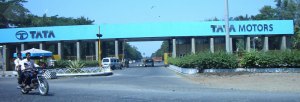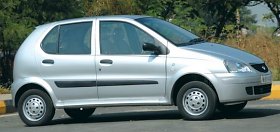
| Jaguar (UK) |
| Land Rover (UK) |
Main plants and R&D center (cars): Pune

FY2016/17: 1,157,808 units (including 604,009 units of Jaguar / Land Rover)
FY2015/16: 1,066,254 units (including 521,571 units of Jaguar / Land Rover)
FY2014/15: 997,550 units (including 470,523 units of Jaguar / Land Rover)
FY2013/14: 1,020,546 units (including 429,861 units of Jaguar / Land Rover)
FY2012/13: 1,191,979 units (including 372,062 units of Jaguar / Land Rover)
FY2011/12: 1,269,483 units (including 314,433 units of Jaguar / Land Rover)
FY2010/11: 1,080,994 units (including 243,621 units of Jaguar / Land Rover)
FY2009/10: 880,396 units (including 193,982 units of Jaguar / Land Rover)
FY2008/09: 506,421 units (passenger cars: 214,428 units)
FY2007/08: 585,649 units (passenger cars: 232,864 units)
FY2006/07: 580,280 units (passenger cars: 246,042 units)
Reference:
http://www.tatamotors.com/investor/annual-reports/
In 1991, Tata entered passenger car market with Sierra, a cheap 4WD sport utility. The same platform gave birth to Sumo and Safari in the next few years. However, its first road car was Indica hatchback of 1998. It was styled by Italdesign and engineed with the help of Western consultants. Owing to its low price, it immediately became the most popular car in India. It was even exported to the UK as CityRover.
 Indica (1998)
Indica (1998)The core business of Tata Motors remained to be commercial vehicles, i.e. light and heavy trucks, bus, vans and utility vehicles. Its road car division was handicapped by the fact that most Indian people could not afford to own private cars. Under the leadership of Ratan Tata (great grandson of the founder), Tata pursued to build a car cheap enough for Indian people. The result was Tata Nano, a rear-engined mini car designed to start from just 100,000 Rupees (US$2,000), making it by far the cheapest car in the world. It caught the attention of the world in its 2008 debut.
 Nano (2008)
Nano (2008)In the same year, Tata surprised the world again by acquiring Jaguar Land Rover from the cash-short Ford.